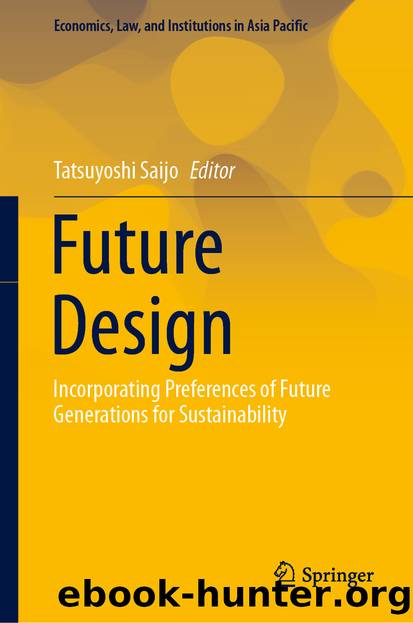Future Design by Unknown

Author:Unknown
Language: eng
Format: epub
ISBN: 9789811554070
Publisher: Springer Singapore
1 Introduction
Human society relies on various types and forms of resources on earth. Many of the resources and materials that we use in our daily lives, such as drinking water, electricity and construction materials, can be traced back to a variety of natural resources. These natural resources are the foundation of society and lives of human beings.
There are various kinds of natural resources, including energy-related resources such as petroleum and coal, water resources, minerals, biomasses, and so on. Petroleum and coal, for example, are among those belonging to the non-renewable category, which comprises resources physically dwindling in quantity as mankind continues to consume their limited supply. If our generation overconsumes such resources, people of future generations would not be able to benefit from them in the ways that the current generation has. Depletion of such natural resources would potentially result in significant disadvantages for future generations. It is therefore fundamentally important to share natural resources not only among those of the same generation but also between generations, so that resources continue to remain available for utilization by future generations.
Among the various types of resources, we direct our attention to water with a special focus on ground water in this chapter. Water is a resource that circulates on earth through the cycle of rainfall and evaporation driven by solar energy. Water may be categorizes as a renewable resource in that respect. However, the potential quantity of water in a particular region, in other words, the amount of water resources available for use in the region, depends largely on physical conditions and regional characteristics. This becomes evident when considering the differences in the amount of rainfall in different parts of the world. In fact, in many regions on earth, the amount of rainfall is extremely limited, and therefore the amount of water available for use is limited. Depending on the region, droughts are expected to occur quite readily due to future climactic changes, in addition to regional conditions including physical conditions. The population on earth has already exceeded seven billion and a further population increase is anticipated, primarily in the Asian and African regions (Population Division of the Department of Economic and Social Affairs, UN 2007). Securing water is expected to become an increasingly important issue in the future, because the demand for water resources—such as domestic water used as drinking water, agricultural water, and industrial water—will continue to accelerate, and the consumption of water resources is predicted to increase worldwide (IPCC 2014).
Fresh water comprises only about 2.5% of all water resources that exist on earth. In other words, much of the existing water is seawater (saline water), which mankind cannot use directly for domestic consumption or for agriculture. Furthermore, only about 30% of the world’s fresh water is actually usable; the remaining 70% exists in forms such as water frozen in glaciers and snow, or trapped in permafrost layers, which prevent humans from using it directly. Unfortunately, many people probably have an image of abundant water on earth, but in reality, the amount of usable water is limited.
Download
This site does not store any files on its server. We only index and link to content provided by other sites. Please contact the content providers to delete copyright contents if any and email us, we'll remove relevant links or contents immediately.
Kathy Andrews Collection by Kathy Andrews(10522)
The remains of the day by Kazuo Ishiguro(7553)
Spare by Prince Harry The Duke of Sussex(4199)
Paper Towns by Green John(4169)
The Body: A Guide for Occupants by Bill Bryson(3802)
Be in a Treehouse by Pete Nelson(3215)
Harry Potter and the Goblet Of Fire by J.K. Rowling(3047)
Goodbye Paradise(2964)
Never by Ken Follett(2885)
Into Thin Air by Jon Krakauer(2703)
The Remains of the Day by Kazuo Ishiguro(2620)
The Genius of Japanese Carpentry by Azby Brown(2609)
The Cellar by Natasha Preston(2595)
Drawing Shortcuts: Developing Quick Drawing Skills Using Today's Technology by Leggitt Jim(2532)
120 Days of Sodom by Marquis de Sade(2439)
Architecture 101 by Nicole Bridge(2351)
The Man Who Died Twice by Richard Osman(2300)
Machine Learning at Scale with H2O by Gregory Keys | David Whiting(2293)
Fairy Tale by Stephen King(2073)
